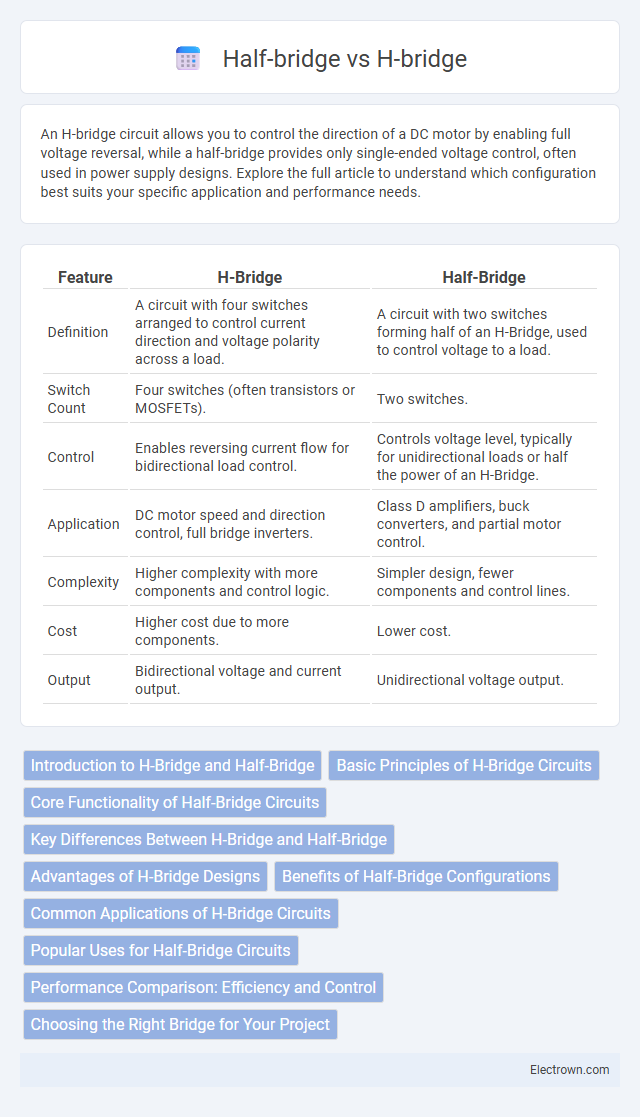An H-bridge circuit allows you to control the direction of a DC motor by enabling full voltage reversal, while a half-bridge provides only single-ended voltage control, often used in power supply designs. Explore the full article to understand which configuration best suits your specific application and performance needs.
Table of Comparison
| Feature | H-Bridge | Half-Bridge |
|---|---|---|
| Definition | A circuit with four switches arranged to control current direction and voltage polarity across a load. | A circuit with two switches forming half of an H-Bridge, used to control voltage to a load. |
| Switch Count | Four switches (often transistors or MOSFETs). | Two switches. |
| Control | Enables reversing current flow for bidirectional load control. | Controls voltage level, typically for unidirectional loads or half the power of an H-Bridge. |
| Application | DC motor speed and direction control, full bridge inverters. | Class D amplifiers, buck converters, and partial motor control. |
| Complexity | Higher complexity with more components and control logic. | Simpler design, fewer components and control lines. |
| Cost | Higher cost due to more components. | Lower cost. |
| Output | Bidirectional voltage and current output. | Unidirectional voltage output. |
Introduction to H-Bridge and Half-Bridge
H-bridge and half-bridge circuits are essential components in power electronics, primarily used for controlling the direction and flow of current in motors and transformers. An H-bridge consists of four switches arranged in a bridge configuration to allow bidirectional current flow, enabling precise motor control and braking functions. The half-bridge uses only two switches and is commonly employed in voltage regulation and DC-DC converters, offering simpler design but limited directional control compared to the H-bridge.
Basic Principles of H-Bridge Circuits
H-bridge circuits utilize four switches arranged in an H-shaped configuration to control the direction of current through a load, enabling bidirectional motor control. Half-bridge circuits, in contrast, use only two switches and provide unidirectional control, typically powering one half of a load at a time. Your choice depends on whether you need precise motor direction control, with H-bridge offering full reversibility and half-bridge providing simpler, partial control.
Core Functionality of Half-Bridge Circuits
Half-bridge circuits function by using two switching devices connected in series across a power supply to control the voltage applied to a load, enabling bidirectional control and efficient power conversion. This configuration allows for precise control of motor speed and direction while minimizing component count and complexity compared to full H-bridge circuits. The half-bridge is essential in applications such as synchronous DC-DC converters and class D audio amplifiers, where efficient switching and voltage regulation are critical.
Key Differences Between H-Bridge and Half-Bridge
H-Bridge and Half-Bridge are power electronic circuits primarily used in motor control and inverter applications. An H-Bridge consists of four switches arranged in a bridge configuration, allowing bidirectional current flow and full control over motor direction, while a Half-Bridge contains only two switches and is capable of controlling power in one direction with reduced complexity and cost. Your choice depends on the requirement for directional control and complexity, with the H-Bridge offering greater versatility and the Half-Bridge serving simpler, unidirectional loads.
Advantages of H-Bridge Designs
H-bridge designs offer superior control over motor direction and speed, enabling full bidirectional operation with efficient switching capabilities. Their ability to provide regenerative braking and precise torque control enhances performance in robotics and electric vehicle applications. By using an H-bridge, you gain more flexibility in managing complex motor control tasks compared to half-bridge configurations.
Benefits of Half-Bridge Configurations
Half-bridge configurations offer enhanced efficiency and reduced component count compared to full H-bridge designs, making them ideal for applications with space and cost constraints. They provide effective voltage utilization and simpler gate drive circuitry, resulting in lower switching losses and improved thermal management. The half-bridge topology also enables easier implementation of synchronous rectification, further boosting power conversion efficiency.
Common Applications of H-Bridge Circuits
H-bridge circuits are commonly used in DC motor control applications, allowing precise bidirectional speed and direction control by switching voltage polarity. They are also essential in robotics for driving actuators and controlling servo motors, enabling complex movement and positioning tasks. Your projects involving reversible motor operation or PWM speed modulation benefit significantly from the versatility of H-bridge designs.
Popular Uses for Half-Bridge Circuits
Half-bridge circuits are widely used in applications such as DC-DC converters, motor drivers, and audio amplifiers where efficient power switching is essential. They offer a compact and cost-effective solution for controlling medium power loads and enable precise voltage regulation and waveform generation. Half-bridge configurations are particularly popular in automotive electronics and renewable energy systems for inverter and power management functions.
Performance Comparison: Efficiency and Control
H-bridge circuits offer superior control over motor direction and braking, providing enhanced efficiency in bidirectional power delivery compared to half-bridge designs. Half-bridge configurations typically exhibit lower switching losses and simpler control schemes, making them more efficient for unidirectional applications. Your choice depends on whether precise motor control or higher efficiency in simpler systems is the priority.
Choosing the Right Bridge for Your Project
Selecting the right bridge for your project depends on power requirements and control complexity; H-bridges provide full bidirectional control, ideal for DC motor applications requiring precise speed and direction management. Half-bridges offer simpler design and cost-effectiveness for applications with unidirectional current flow or lower power demands, commonly used in power supply circuits and audio amplifiers. Careful evaluation of load characteristics, switching frequency, and voltage levels determines whether an H-bridge or half-bridge topology best meets your project's efficiency and performance needs.
h-bridge vs half-bridge Infographic

 electrown.com
electrown.com